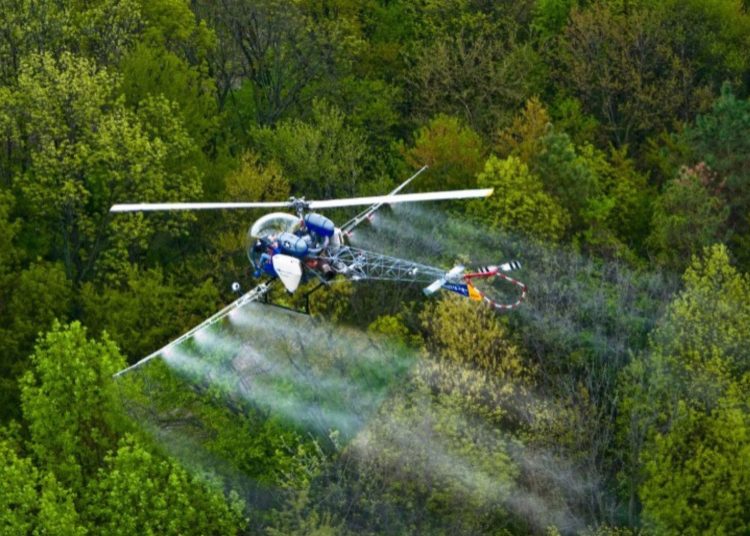Recent media reports have highlighted an alarming development in New Brunswick: a cluster of mysterious brain diseases. These cases, numbering in the hundreds, are appearing in New Brunswick and perhaps in neighboring Nova Scotia. They have been found in young and older adults and in clusters not related by genetics. What’s also troubling is that these diseases often appear to start during periods of heavy glyphosate spraying—particularly in late summer and early fall.
Glyphosate, a key ingredient in widely used herbicides such as Roundup, is sprayed extensively in New Brunswick, more so perhaps than in any other region of Canada. Aerial spraying to manage forestry operations means the chemicals can spread widely through air, soil, and water. Recent reports indicate that many affected individuals have tested positive for glyphosate in their bodies, and at least one has a very high level.
I am a physician from Hawaii, and I’ve also practiced on the island of Guam. Although thousands of miles from eastern Canada, our experiences may offer some critical insights into New Brunswick’s challenges. A recent column in the Telegraph-Journal reviewed our experience in Hawaii but did not cover the research from Guam or the more recent research on the potential toxicity of Roundup-like herbicides.

The deadly mystery of neurologic diseases on Guam
In the aftermath of World War II, the island of Guam witnessed a devastating outbreak of neurological diseases. For years, scientists struggled to uncover the cause. Eventually, the spotlight turned to a potent neurotoxin, BMAA (Beta-Methylamino-L-Alanine). It is produced by cyanobacteria that live on the roots of certain plants on Guam. The toxins entered the island’s food chain directly when these plants were consumed by Guamanians or indirectly through animals that ate the plants and then were eaten by the local population. After dietary changes in Guam, no new cases have surfaced for over two decades.
But now, a strikingly similar scenario could be unfolding in New Brunswick, Canada. Recent research suggests that common herbicides like Roundup may significantly boost the growth of similar toxin-producing cyanobacteria in salt and freshwater ecosystems. As seen in Guam, these cyanobacteria are known to produce BMAA.
Late summer and fall are the peak seasons for aerial spraying of glyphosate-based herbicides, which coincides with the highest BMAA levels in Canadian waterways. Interestingly, this is also when many patients begin showing symptoms of the mysterious neurological illness. While other chemicals, such as fertilizers, have been known to stimulate the growth of cyanobacteria, Roundup appears to be an especially powerful growth enhancer.
Dr. Marrero, a neurologist treating many of the affected New Brunswick patients, has requested testing for BMAA in individuals suffering from the condition. So far, however, no tests have been carried out.
Glyphosate’s global reach
Glyphosate’s health issues are not limited to New Brunswick. In the 1990s, glyphosate-based herbicides such as Roundup entered the United States and Canada food chain. They are the most heavily sprayed herbicides in history and are now found in most GMO and many non-GMO foods. Glyphosate-based herbicides have become ubiquitous in both countries’ water and food supply. Hundreds of studies have emerged over the past decade, highlighting the dangers posed by these herbicides.
One major concern is glyphosate’s impact on the microbiome—the collection of bacteria that inhabit our bodies, soil, and water systems. Our gut bacteria play a critical role in maintaining brain function, immune health, and digestive processes in humans. Glyphosate’s effect on aquatic microbiomes is also linked to cyanobacteria blooms in lakes and streams. Glyphosate exposure is associated with inflammation, oxidative stress, organ toxicity, and hormone imbalances.
Emerging research and growing health concerns
Since glyphosate became pervasive in our food and environment, rates of chronic diseases such as cancer in young people, diabetes, obesity, and neurological conditions like Alzheimer’s and Parkinson’s have increased dramatically. Some researchers suggest that this is no coincidence. There is growing evidence that even low-level, chronic exposure to glyphosate may contribute to a wide range of health issues, from metabolic disorders and autoimmune diseases to anxiety, autism, and depression.
The bottom line is that the heavy aerial spraying in New Brunswick may indirectly produce enough of the potent neurotoxin BMAA to cause neurologic illnesses similar to those in Guam. For the rest of us, the pervasive, chronic low-level exposure in our food and drinking water may also be a problem.
A call for action
The people of New Brunswick deserve answers. To ensure public safety, rigorous environmental and biological testing should be conducted. The current cluster of brain diseases may serve as a warning, not just for New Brunswick but for communities worldwide. The health of our population is deteriorating, and we must take steps to address the chemicals contaminating our food, water, air, and bodies.
Lee A. Evslin, MD, is a Kaua’i-based pediatrician and the former CEO of Kaua’i Medical Clinic and Wilcox Hospital. He served on the state-sponsored task force that analyzed pesticide usage on Kaua’i and received special recognition from the American Academy of Pediatrics for his work on pesticide legislation. He was a Keynote speaker at the 2022 UN General Assembly Science Summit and author of Breakfast at Monsanto’s: Is Roundup in our food making us fatter, sicker, and sadder?




![Delayed restrictions on herbicide prompt failing grade from environmental group [video]](https://nbmediacoop.org/wp-content/uploads/2025/09/StopSprayingSept92025-350x250.jpg)




![Is pollution from industry causing the neurological disease ALS in New Brunswick? [video]](https://nbmediacoop.org/wp-content/uploads/2025/10/Quintin-Soloviev-Belledune_Generating_Station_in_New_Brunswick_Canada-120x86.jpg)
